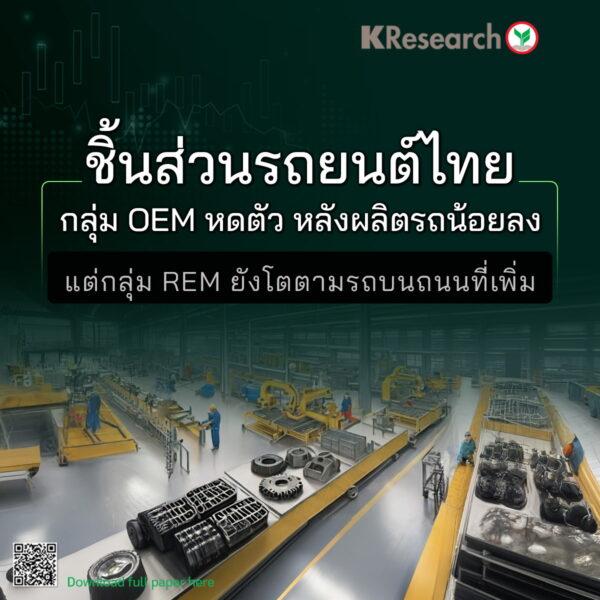
Thai Auto Parts Industry Trends.

The demands for Thai OEM (Original Equipment Manufacturing) auto parts sent to the car production line are expected to shrink in 2024, with the domestic sales expected to shrink by 11.9% after the volume of car production in Thailand is expected to shrink to 1.64 million units due to the decrease in the domestic car sales and the recent increase in BEV imports.
Meanwhile, Thai OEM parts exports are expected to shrink by 2.9% after the volume of car production in major export markets such as other ASEAN countries (excluding Thailand) led by Indonesia, which is facing a problem of high domestic car sales contraction, is expected to decline while Vietnam has begun to import cars instead of producing them domestically.
Thai REM (Replacement Equipment Manufacturing) parts, or spare parts used for car maintenance, are expected to probably grow by 6.4% in 2024, in line with the increase in cars on the roads in Thailand, especially, cars over 7 years old, which are likely to require higher amounts of REM parts.
Respective to the Thai REM parts exports, they are expected to grow by less than 2.0% after facing competition from Chinese parts, especially, after cars exported from China have started to take a larger share of the Thai car export market, particularly, in major markets such as ASEAN. This resulted in a decrease in the demands for Thai REM parts.
Car exports from China had begun to take a larger share of the Thai car export markets, especially, in the ASEAN’s main market to the extent that last year Thailand accounted for only 24.6% of the car import share of the ASEAN markets (excluding Thailand). This factor eventually resulted in the demands for Thai REM parts exported to the ASEAN markets to decrease to 19.6% which were in contrast to the continuous increase in the imports from China that were high up to 25.1%.
Thailand is considered one of the global main car parts production bases, with more than 1.8 million cars being assembled in 2023, making the country ranked the 10th in the world. By relying on the complete supply chain, starting from being a source of many important raw materials such as rubbers and plastics, two groups of car parts which are OEM parts to support car productions and REM parts to support the maintenance markets are manufactured. Although some parts are imported, yet, the proportion is not very high before being delivered to customers and customer groups, including car manufacturers, spare parts shops, and garages, both domestically and internationally.
Thai Auto Parts Industrial Risks.
- The transition to BEV technology has directly affected the demands for oil-powered auto parts as BEV production is likely to start to rapidly consume the share of oil-powered cars in the next 1-2 years after car manufacturers participating in the EV3.0 and EV3.5 projects have to manufactured cars to offset the current imports of more than 100,000 units. In addition, even though some Thai auto parts can be used in the BEV production line, we have to admit that the amounts of parts used in BEV manufactures has significantly decreased and more parts are being imported from China for manufacturing which will indeed directly affect Thai auto parts.
- Competition with exported parts from China which tends to increase significantly, both domestically and in the export market as a result of both China’s rapid increase in auto part production capacity to support auto production in China itself, which must find an export market to produce at a low cost, and the fact that exported cars from China are facing trade barriers from the United States, European Union (EU), Canada, which may include other allies in the future, has caused China to have to find more markets for exporting, i. e. Thailand or Thailand’s original export markets, which will eventually affect both OEM and REM parts in Thailand itself or exporting to Thailand’s original main export countries that have decreased due to the increasing competitions.
- Government policies that may affect the demands for automotive parts such as scrap disposal or exchanging old cars for new ones, which may be reconsidered in the future to maintain the productions of new cars in the country. Although the project will help increase the demands for OEM parts to some extent, yet, the demands for REM parts will decrease due to the loss of old cars. However, there are still issues that need to be considered such as the budget, the types of cars to be supported whether they will really help stimulate the use of OEM parts in the country or not including the second-hand car markets.



